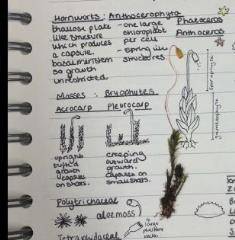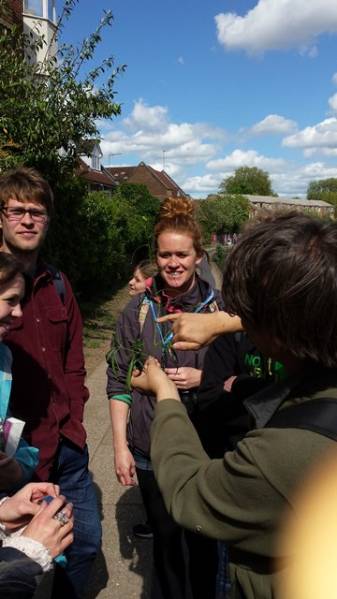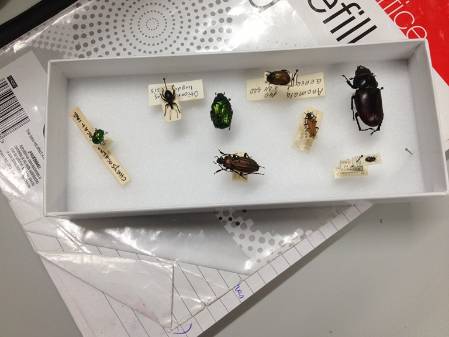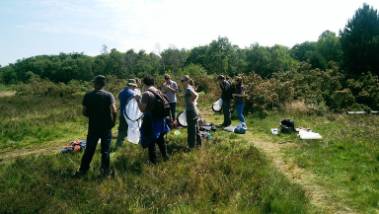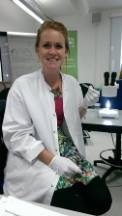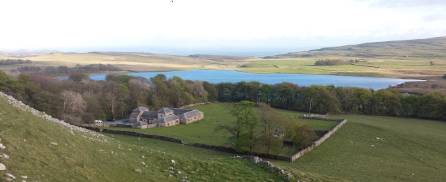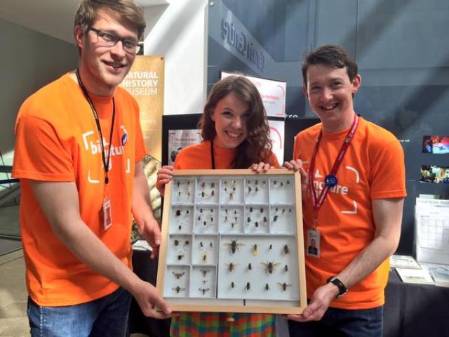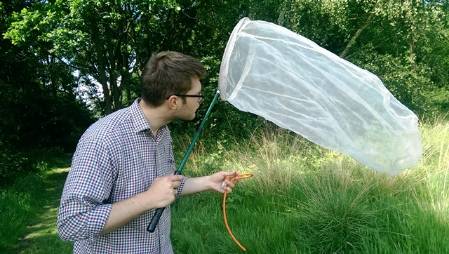Our trainees on the Identification Trainers for the Future project have been extremely busy since our last blog post, here's Mike Waller with an update on what they have been getting up to!
The trainees puzzle over their latest capture (L-R: Sally, Anthony, Mike and Katy)
Our timetables, until now a collage of various colours, have become a very busy reality over the last two months. We got our teeth into another batch of long-anticipated ID workshops - Flowering Plants, Beetles, Flies and Earthworms. I think I speak for everyone when I say the skills and knowledge we've been passed by some of the leading scientific experts in the Museum have been rich, extensive and unique. Developing techniques to hoard as much of this golden information as possible have become paramount.
I've already gathered a thick stack of mixed ID keys, notes, powerpoint handouts and even the odd specimen - usually midway through the processing to go into my personal collection. Sally has taken her learning consolidation to a new level and is producing an incredible assemblage of annotated line drawings and intricate watercolours in her note book. She'll be blogging about that separately, but we're all a little jealous!
An extract from Sallys notebook
The first of these workshops was a one-day instalment of flowering plants out in the wilds of East London with Mark Spencer. We met promptly for 9.00 at Mile End tube station before heading out in the company of other trainees from a similar scheme called Wild Talent being run by the London Wildlife Trust (also funded by the HLF's Skills for the Future programme), and people who narrowly missed out on getting the traineeship during the first round. Indeed, several places have been made available on all workshops for the other 20 trainee applicants as an opportunity to maximise the skills-base across the board. It was great to see them again!
Mark Spencer highlighting some of the finer points of plant identification
After a scorching day keying out Fabacae and crucifers, dodging cyclists and discussing the horror of path-side 'tidying', we finished in Mark's local pub for a well-earned pint. As always, Mark's casual ability to blend good science, humour and memorable anecdotes always makes for a superb time. We all very much look forward to our next sessions with him in July.
Next up was our very first invertebrate workshop, and what better to start with than beetles - the group within which both Katy and Anthony find their true passion. This workshop was a solid four-day stretch that began with Roger Booth taking us through the depths of beetle anatomy followed by some family keying. Max Barclay provided a two-part lecture on world beetle families that, for me, gave a fascinating insight into the truly spectacular speciation and morphological diversity of the group acoss the planet.
As our confidence grew, we began to use specific familiy keys to make accurate species identifications of some of the more challenging groups such as Elateridae or the 'click' beetles. Michael Geiser and Roger offered invaluable help during this process as their oceans of knowledge were repeatedly called upon.
A small selection of beetles for identification
Just as we thought we were getting to understand insects, BOOM, in swept the seemingly impenetrable order of flies - a group with unfathomable diversity! Luckily we were in very good hands as we were led through the array of sub-orders by Erica McAlister, Duncan Sivell, Zoe Adams, Daniel Whitemore and the AMC's very own Chris Raper.
In similar style to the beetles, we used familiy keys to start with then slowly graduated to species identifications where possible. This workshop however came with a difference and on the second day, we all met at Wimbledon Common for a day out collecting.
With nets, pooters and pots at the ready, we were unleased on the varied mix of heathland, pastures and oak woodlands to capture what we could. The weather couldn't have been better and gave us a golden opportunity to use collecting techniques in the field. Once back in the Museum we were then able to pin and mount our specimens for our personal collections.
Left: Out on Wimbledon Common with the Diptera team. Right: Chloe back in the lab working on her diptera slide preparation
Our most recent workshop went subterranean with Emma Sherlock as we dug up seemingly half of the Wildfowl & Wetlands Trusts London Wetland Centre in the pursuit of earthworms. Using our trusty spades, and encouraged with the possibility of encountering a rare species, we sampled different habitats around the reserve to gain a good range of species which we then took back to the lab for identification the following day. Emma's unbridled passion for earthworms is infections and we all developed a new-found interest to take forward.
If that wasn't enough, we all packed our walking boots and set out for our placements with the Field Studies Council where we were based at various FSC Centres scattered up and down the country.
During May, I made my way north to Malham Tarn, whilst Chloe took heading north to the extreme with a week at Kindrogan and Milport on the edge of the Cairngorms National Park. Meanwhile, Anthony settled at Flatford Mill in Suffolk. Sally followed the South Wales coast to Dale Fort and Katy battled her way through the winding roads of North Wales to Rhyd-y-Creau in the mists of Snowdonia.
The focus of each of our placements was 2-fold: to observe the identification courses each centre was running and to assist with the outdoor teaching for which the FSC is renowned. I got to observe a beginners course called 'Spring Wildflowers of the Dales' which, as you'd expect, concentrated on the botanical.
It was led by local botanist Judith Allinson who taught a mixture of plant structure and lineage with a good dose of field visits to observe some of the specialist plants of the stunning limestone pastures, pavements and hay meadows. Having not been to the Dales proper before, I was continually stunned by this landscape of dramatic limestone cliffs and thick green meadows chequered by moss-drenched dry stone walls where the only sounds were the melancholy warbles of distant curlews. Highlights for me were the rafts of early purple orchids, adder's-tongue ferns and a hungry peregrine attempting to snatch Lapwing chicks on the tarn shore
Malham Tarn FSC Centre
The second part of my stay saw a sudden shift from pupil to teacher as various school groups, ranging from 8-14 year olds, visited for day trips and longer stays. This meant hanging out with the tireless field teachers who work extremely long hours to meet the educational needs of over-excited children!
It was a real privilege to see the field teacher's skills in action, but equally how challenging their roles can be. Trying to deliver a range of syllabus-based content that is relevant and exciting to different age groups, whilst trying to avoid the hazards of controlling a large group of children in an unpredicatable environment is very hard indeed. These observations were echoed by the other trainees who also gained immesurably from their experiences.
To round off our teaching and learning, Sally, Anthony and I also got stuck into some more people engagement at Big Nature Day here at the Museum. This is a coming together of over 50 different specialist wildlife organisations from across the UK. These included the more familiar groups such as the BSBI and iSpot, but it also provided an opportunity for some of the lesser-known societies such as the Conchological Society of Great Britain and Ireland and the British Pteridological Society to get their name out there.
Like Lyme Regis, this was a wonderful opportunity to showcase the work of the Angela Marmont Centre while also browsing and networking with some fascinating wildlife groups. As trainees, we ran our own table providing microscopes to observe lichens and several drawers filled with UK insects and bee mimics. I also spent some of my time at the Orchid Observers stand where I helped answer questions about the project alongside Kath Castillo, Fred Rumsey and Mark Spencer.
Mike, Sally and Anthony at Big Nature Day
All in all, an inspiring day, and an inspiring, and hectic couple of months! As the traineeship progresses, we're all looking forward to our next few workshops, which include Freshwater Invertebrates, Lepidoptera and Hymenoptera, as well as our short field trip down to the Isle of Purbeck before we all set sail in September for our three month curation placements at various departments around the Museum. Make sure you stay tuned for the next instalment of the Identification Trainees saga!
Your blog author, Mike Waller
Thanks Mike! Don't forget you can find out more about the Identification Trainers for the Future project at www.nhm.ac.uk/idtrainers, including how and when to apply for next years traineeship positions.




